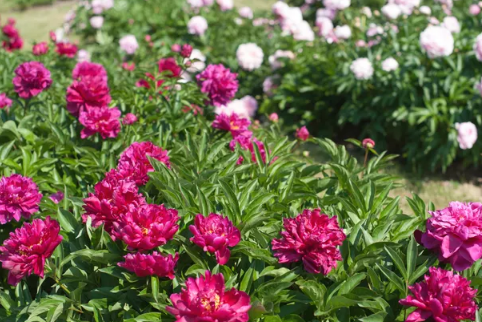Few plants have a longer history of cultivation or a more beloved role in ornamental gardening than the peony. Among the many types of Paeonia, none are more popular or important than the Chinese peony (Paeonia lactiflora), also known simply as the herbaceous peony. These clump-forming perennial shrubs are famous for their large, fragrant blooms, which typically appear in late spring to early summer.
Container-grown peonies from nurseries are usually planted in the spring, while bare-root peonies—commonly purchased online—are best planted in the fall. Peonies grow slowly and may take up to three years to bloom, but the wait is well worth it: once established, these plants can live for 100 years or more.
Peonies contain a toxic compound called paeonol, which can cause mild digestive upset if ingested by pets. However, they’re not listed as toxic to humans.

Peony Care Overview
Peonies require cold winters to go dormant, making them unsuitable for warm climates above USDA Zone 8. On the bright side, many varieties can withstand frigid temps down to -50°F, which makes them favorites in Northern gardens.
Proper spacing and airflow are critical when planting, since overcrowding promotes disease. Keep plants 3–4 feet apart and avoid planting near large shrubs or trees that may compete for nutrients. Peonies need winter chill to set buds, so make sure the crown is planted no more than 2 inches below the soil surface. For potted peonies, plant them at the same depth they grew in the container.
Because their big blooms are top-heavy, peonies often flop over—especially after a rain. If you don’t want to invest in special peony rings, you can use wooden or metal stakes and twine to support them.
The only regular maintenance required is cutting back foliage in the fall and keeping plants tidy during the growing season by removing any diseased leaves.
Light
Peonies thrive in full sun and need at least 6 hours of direct sunlight per day to bloom well. In warmer climates, a bit of afternoon shade helps protect them from intense midday heat.
Soil
Peonies prefer rich, well-drained soil. Avoid wet or soggy locations. If your soil is sandy or heavy with clay, mix in organic matter to improve structure—just don’t over-fertilize, as this can encourage botrytis (gray mold).
Always mix soil amendments thoroughly. While peonies prefer neutral pH, they tolerate slightly acidic soils too.
Water
In regions with regular rainfall, peonies usually don’t need additional watering. Their water needs peak in spring and fall, so if you experience drought in these seasons, water deeply but infrequently to maintain consistent soil moisture. About 1 inch of water per week (including rainfall) is ideal.
Temperature & Humidity
Peonies are hardy perennials that do best in cool climates. Many varieties survive temperatures as low as -50°F. They need cold winters to fully go dormant and reset for spring growth. Chinese peonies grow best in Zones 3–7, though some northern parts of Zone 8 are also suitable.
They struggle in hot, humid weather—especially during bloom time. In warmer regions, try growing early-blooming varieties that flower before summer heat sets in.
Fertilizer
Peonies generally don’t need fertilizer unless your soil lacks nutrients. If blooms are sparse despite good conditions, apply a low-nitrogen fertilizer (like bulb food) after flowering or in late summer around the drip line.
Avoid unnecessary fertilizing—too much can suppress blooming.

Pruning
Deadhead spent blooms to reduce the risk of fungal disease and keep plants looking tidy. Cut flower stems just above a strong set of leaves.
In fall, cut the whole plant back to just above ground level and dispose of the debris to eliminate overwintering fungal spores.
Propagation
The best way to propagate peonies is by dividing the root clump—though this can be a bit tricky:
-
In fall, cut stems a few inches above ground.
-
Carefully dig up the entire root mass.
-
Using a sharp knife, divide the rootball into sections, each with 3–5 “eyes” (growth buds).
-
Replant with buds no more than 2 inches deep. Planting too deep can prevent blooming.
Be patient—divisions may take three or more years to mature and bloom.
Growing Peonies from Seed
Nearly all peonies are hybrids and don’t grow true from seed. Even with reputable commercial seed, plants may take years—sometimes a decade—to flower. As a result, most gardeners prefer propagation by division rather than seed.
Peonies in Pots
Because peonies grow tall and top-heavy, they’re prone to tipping over in containers. If you want to grow them this way, choose dwarf hybrid varieties often labeled as patio peonies.
Winter Care
Too much winter protection can backfire—peonies need winter cold to trigger bud development. Some gardeners pile on mulch, only to be disappointed when their plants fail to bloom.
Instead, just cut plants back to ground level before snowfall and clear away all debris to prevent overwintering fungal spores.
Pests & Diseases
The most common issue for Chinese peonies is botrytis blight and other fungal diseases, especially in cool, wet spring weather. If you notice blackened, wilting stems or leaves, remove the infected parts immediately.
In fall, cut plants back to a few inches and throw all debris in the trash—not the compost. If fungal problems persist, start spraying with fungicide weekly early in the growing season.
Powdery mildew (a white coating on leaves and stems) can appear in hot, humid summers. It’s mostly cosmetic and won’t harm the plant, but a fall cleanup helps reduce future outbreaks.
Peonies have few serious insect pests but may occasionally suffer from thrips, scale, mealybugs, bulb mites, or beetles. These can be controlled with neem oil or organic insecticidal sprays with pyrethrins. Ants on peony buds are harmless—they’re just attracted to the sweet nectar.
How to Encourage Blooming
If your peony is mature and gets enough sunlight, it should bloom reliably. But don’t be discouraged if it doesn’t flower the first couple of years—new bare-root or divided peonies can take three years to bloom.
Peonies planted too deep often fail to flower. Try lifting and replanting them a bit shallower.
If your soil is poor, applying bulb fertilizer in the fall may encourage spring blooms—but don’t overdo it, as too much fertilizer can also reduce blooming.
Also avoid over-harvesting blooms for cut flowers. If you cut too many in one season, you may get fewer flowers the next. As a rule of thumb, don’t cut more than one-third of the blooms.
Common Problems
Floppy Flower Stems
The massive double blooms that make peonies so stunning are also their weakness—many varieties collapse under their own weight, especially after rain. Use a grid-style plant support or opt for single or anemone-style varieties that are lighter and more upright.
Mushy, Collapsing Plants
This is a hallmark sign of botrytis blight or another serious fungal infection. By the time symptoms appear, it’s often too late—dig up and discard the plant. If peonies in your garden are prone to fungal issues, early treatment with fungicide is your best defense.
Ants on the Blooms
No worries! Ants are just attracted to the nectar and don’t harm the flowers. It’s easy to brush them off before bringing flowers indoors for arrangements.

